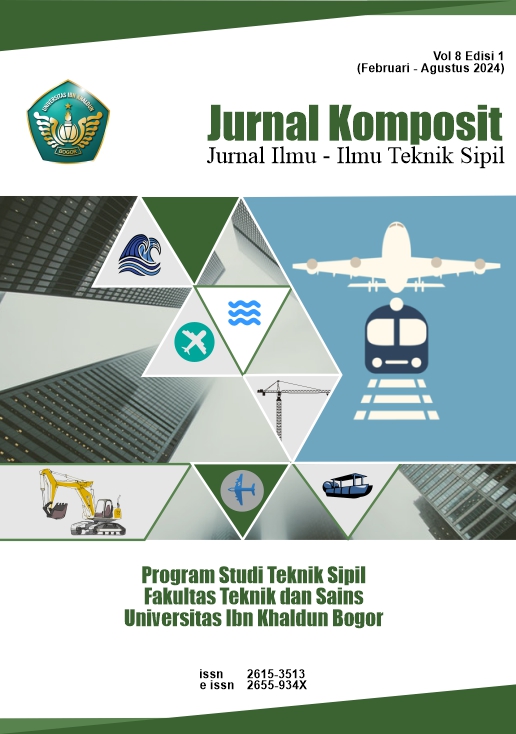Analisis penerapan Area Traffic Control System (ATCS) di Pusat Kota Ambon
DOI:
https://doi.org/10.32832/komposit.v8i1.14894Kata Kunci:
Area Traffic Control System, Intelligence Transportation System, Analytical Hierarchy ProcessAbstrak
Area Traffic Control System (ATCS) adalah bagian dari Intelligent Transportation System yang berfungsi mengkoordinasi alat pemberi isyarat lalu lintas sesuai kondisi nyata di lapangan sehingga memberikan pengaruh positif pada lalu lintas di persimpangan dan jaringan transportasi secara keseluruhan. Oleh karena itu sebelum penerapannya, perlu diteliti faktor yang mempengaruhi pemilihan lokasi penerapannya agar diterapkan di persimpangan yang tepat. Penelitian dilakukan pada enam persimpangan yang saat ini menggunakan alat pemberi isyarat lalu lintas di pusat kota Ambon. Dilakukan pencarian faktor dan sub faktor yang mempengaruhi pemilihan lokasi penerapan Area Traffic Control System di pusat kota Ambon dengan metode Analytical Hierarchy Process (AHP) yang akan digunakan sebagai bobot untuk analisis skoring untuk menentukan persimpangan yang cocok diterapkan sistem ini. Berdasarkan hasil Analytical Hierarchy Process, didapatkan faktor yang paling mempengaruhi adalah kinerja jalan, dengan bobot sebesar 58,4%. Penerapan sistem ATCS lebih disarankan pada persimpangan dengan VC ratio yang baik, berjarak tidak terlalu jauh dengan persimpangan berikutnya, dan terletak di kawasan aktivitas komersial. Dari enam persimpangan Al-Fatah memiliki skor total tertinggi, akan tetapi skor total lima persimpangan lainnya juga cukup baik, sehingga system ATCS dapat diterapkan di ke enam lokasi studi.
Referensi
Kurniati, N. L. (2019). Optimisasi Kinerja Area Traffic Control System (ATCS) di Kota Balikpapan. Jurnal Penelitian Transportasi Darat, 155-164.
Mamentu, S. S., Lefrandt, L. I., & & Timboeleng, J. A. (2019). Evaluasi penerapan area traffic control system (ATCS) pada simpang bersinyal (studi kasus: Persimpangan Teling). Jurnal Sipil Statik, 209-2018.
Maulidya, I. (2022). Optimisasi Kinerja Area Traffic Control System (ATCS) di Simpang Dome Kota Balikpapan. Warta Penelitian Perhubungan, 119-128.
Nur, B., Wulan, N. D., & Fadil, M. (2020). Efektivitas Program RTTIC Dan ATCS untuk Mengatasi Kemacetan di Kota Malang (Studi Kasus: DISHUB Kota Malang). Tantangan Penyelenggaraan Pemerintahan di Era Revolusi Indusri 4.0 (pp. 357-373). Prosiding Simposium Nasional.
Saaty, T. L. (1980). The Analytic Hierarchy Process, Planning, Priority. McGraw-Hill.
Sutandi, A. C. (2007). Performance Evaluation of Advanced Traffic Control Systems at Signalised Intersections far from Adjacent Intersections. Civil Engineering Dimension, 77-84.
Sutandi, A. C. (2008). Comparative Analysis of Advanced and Fixed Time Traffic Control Systems in Increasing Traffic Performance. Media Teknik Sipil Universitas Kristen Petra.
Sutandi, A. C. (2008). Relationship between Traffic Performance Measures and Significant Variables which Influence the Performance of ATCS. Dinamika Teknik Sipil: Majalah Ilmiah Teknik Sipil, 108-117.
Sutandi, A. C. (2010). Characteristics of Signalized Intersection which need Advanced Traffic Control System Application. Dinamika Teknik Sipil: Majalah Ilmiah Teknik Sipil, 125-130.
Sutandi, A. C., & Dia, H. (2005). Performance Evaluation of an Advanced Traffic Control System in a Developing Country. Proceedings of the Eastern Asia Society for Transportation Studies, 1572-1584.
Sutandi, A. C., & Siswanto, A. (2010). Performance Evaluation of Sydney Coordinated Adaptive Traffic Control Systems in Bandung, Indonesia. Prosiding KoNTekS4 Peluang dan Tantangan dalam Rekayasa Sipil dan Lingkungan (pp. 33-40). Bali: Konverensi Nasional Teknik Sipil IV (KonTeks4).
Tania, N., & Rahmawati, R. (2022). Area Traffic Control System (ATCS) for Supporting Urban Traffic Management in DKI Jakarta. 2022 7th International Conference on Electric Vehicular Technology (ICEVT) (pp. 103-108). Bali: IEEE.
WS, A., Murtejo, T., & Rulhendri, R. (2017). Evaluasi Kinerja Simpang Jalan M.H. Thamrin, Sentul City Kabupaten Bogor. Jurnal Komposit: Jurnal Ilmu-Ilmu Teknik Sipil, 1(1), 37–43. https://doi.org/10.32832/komposit.v1i1.3739
Unduhan
Diterbitkan
Cara Mengutip
Terbitan
Bagian
Lisensi
Hak Cipta (c) 2024 Jurnal Komposit: Jurnal Ilmu-ilmu Teknik Sipil

Artikel ini berlisensiCreative Commons Attribution-NonCommercial-ShareAlike 4.0 International License.
Authors who publish with this journal agree to the following terms (Penulis yang mengajukan publikasi artikel telah menyetujui hal berikut):
- Through this publication, the author agree to submit the copyright of article writing to Jurnal Komposit: Jurnal Ilmu-ilmu Teknik Sipil. This copyright submission takes the form of, but is not limited to: reproduction of the article and parts therein, including photographic reproductions; distribution of articles through printed and electronic documents; and translation of articles(Bahwa melalui publikasi ini, hak cipta penulisan artikel diserahkan kepada Jurnal Komposit: Jurnal Ilmu-ilmu Teknik Sipil. Penyerahan hak cipta ini berupa, namun tidak terbatas pada: perbanyakan artikel dan bagian di dalamnya, termasuk reproduksi fotografi; penyebarluasan artikel melalui dokumen cetak dan elektronik; serta penterjemahan artikel).
- The authors agree to the terms of the Copyright Notice, according to Creative Commons Attribution-NonCommercial-ShareAlike 4.0 International License., which will apply to this article if and when it is published by Jurnal Komposit: Jurnal Ilmu-ilmu Teknik Sipil. (Para penulis setuju dengan ketentuan Pemberitahuan Hak Cipta, sesuai dengan Lisensi Internasional Creative Commons Attribution-NonCommercial-ShareAlike 4.0., yang akan berlaku untuk artikel ini jika dan ketika diterbitkan oleh Jurnal Komposit: Jurnal Ilmu-ilmu Teknik Sipil).

This work is licensed under a Creative Commons Attribution-NonCommercial-ShareAlike 4.0 International License.



.png)










